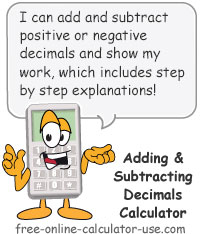IMPORTANT: Numeric entry fields must not contain dollar signs, percent signs, commas, spaces, etc. (only digits 0-9 and decimal points are allowed).
Click the Terms tab above for a more detailed description of each entry.
Step #1
Enter the first number in the equation, free of any commas, spaces or other non-numeric characters (only a single decimal point is allowed). If the number is negative enter a minus sign directly in front of the number (-25).
Step #2
Select either "plus" or "minus" from the operation drop-down menu.
Step #3
Enter the second number in the equation, free of any commas, spaces or other non-numeric characters (only a single decimal point is allowed). If the number is negative enter a minus sign directly in front of the number (-25).
Step #4
the "Add/Subtract Numbers" button and scroll down to see how the solution was reached using long addition or subtraction.


Follow me on any of the social media sites below and be among the first to get a sneak peek at the newest and coolest calculators that are being added or updated each month.